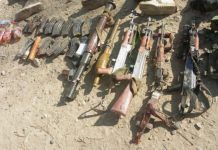DM Monitoring
SEOUL: North Korea’s unprecedented nighttime military parade showcased an unusually broad array of new weapons, from a show-stopping “monster” ballistic missile to previously unseen battle tanks.
The hardware, likely still in varying stages of development, offered leader Kim Jong Un a chance to show the world his cutting-edge military power while adding practical capabilities to the North Korea’s already formidable nuclear and conventional forces, experts said. Kim is walking a fine line, seeking to increase pressure on the United States to ease sanctions while not destroying rapport with US President Donald Trump or Pyongyang’s partners in China.
“Kim Jong Un’s speech was not threatening to the United States, instead labelling North Korea’s nuclear forces as self-defensive,” said Bruce Klingner, a retired CIA North Korea analyst now at the Heritage Foundation. “The clear message was that, counter to US claims, the North Korean nuclear threat has not been solved.”
Video from the parade suggested a huge intercontinental ballistic missile (ICBM) potentially more lethal either because of multiple warheads or a bigger payload, larger missile carriers, a next-generation submarine-launched missile, and advances in conventional weaponry, military analysts said. The star of Saturday’s show was a massive, previously unseen ICBM carried on an equally huge “transporter-erector-launcher” (TEL) vehicle with 11 axles.
Estimated to be 25 to 26 metres (82 to 85 feet) long and 2.5 to 2.9 metres (8 to 9.5 feet) in diameter, the unidentified missile would be the largest road-mobile ICBM in the world, military analysts said. Given that the Hwasong-15, the largest missile ever test-flown by North Korea, can already target anywhere in the United States, the most likely practical use for the new ICBM would be the ability to carry multiple warheads, said Melissa Hanham, deputy director of the Open Nuclear Network.
It is much cheaper for North Korea to add warheads than for the United States to add interceptors, said Jeffrey Lewis, a missile researcher at the James Martin Center for Nonproliferation Studies (CNS). “If each new North Korean ICBM can carry 3-4 warheads, we would need about 12-16 interceptors for each missile,” he said on Twitter. “The last time the U.S. bought 14 interceptors, it cost $1 billion.”
Other analysts said the missile could simply be designed to carry a single, larger warhead. “A bigger warhead doesn’t necessarily mean multiple warheads, a technology I believe North Korea has not secured yet,” said Kim Dong-yup, a former South Korea Navy officer who is now a professor at Kyungnam University’s Far East Institute in Seoul.
Analysts said it was also notable that North Korea appeared to have built the huge new TELs to carry the new missiles. “They have a very limited supply of long TELs they acquired from China,” said another CNS researcher, Dave Schmerler, adding that the lack of vehicles has limited the number of ICBMs that could be deployed.




